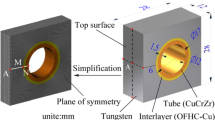Abstract
The first wall of fusion reactor is a plasma-facing component and is a key link to maintain the integrity of the structure during thermal shock induced by plasma disruptions. Previous researches on thermal shock resistance of the first wall lacks coupled thermal/mechanical analysis on heat shock process based on practical operating conditions, such as material melting, solidification and even evaporation etc., which is significant to further understand the heat shock damage mechanism of first wall structures. With the aim to lean more detailed mechanical mechanism of thermal shock damage and then to improve the thermal shock resistance performance of first wall design, the coupled thermal/mechanical response of two typical structure of ITER-like first walls (with different plasma-facing material: one is traditionally Be, the other is functionally graded W–Cu) under the heat shock of 1–2 GW/m2 are computed by the finite element method. Special considerations of elastic–plastic deformation, material melting, solidification are included in numerical models and methods. The mechanical response behaviors of different structures and materials under normal servicing operation as well as plasma disruption conditions are analyzed and investigated comparatively. It is concluded that: (1) During the normal servicing operation state, both kinds of first walls manifest a good thermal and mechanical performance. However, the first wall with graded W–Cu material presents a more complex distribution and larger values of interfacial thermal stress and deformation. (2) In high energy shock pulse induced by plasma disruptions, heat is mainly deposited on PFM layer, complex thermal stress change as well as coupled melting and solidification processes in PFM layer are observed, involving a mechanical irreversible damage of repeated thermal elastic and plastic expansion, contraction and yielding. (3) The mechanically irreversible damages for both mock-ups under the thermal shock with H0 = 1–2 GW/m2 are mainly limited in PFM layer, the internal parts of both mock-ups are protected effectively. (4) In view of thermal/mechanical performance, the first wall with Be PFM mitigates the damages from heat shock at most only in PFM layer with cost of whole PFM layer plastic yielding, while the first wall with graded W–Cu PFM is potential of higher heat shock resistance performance, providing its material gradient as well as cooling capacity are well optimized under practical loading conditions.













Similar content being viewed by others
References
J. Linke, M. Akiba, H. Bolt et al., Performance of beryllium, carbon, and tungsten under intense thermal fluxes. J. Nucl. Mater. 241, 1210–1216 (1997)
M. Wirtz, J. Linke, G. Pintsuk et al., Thermal shock behaviour of tungsten after high flux H-plasma loading. J. Nucl. Mater. 443(1), 497–501 (2013)
Q. Li, X. He et al., Surface damage of tungsten during plasma disruption. J. Hefei Univ. Technol. (Nat. Sci.) 10, 1181–1183 (2008)
G. Arnoux, B. Bazylev, M. Lehnen et al., Heat load measurements on the JET first wall during disruptions. J. Nucl. Mater. 415(1), S817–S820 (2011)
M. Lehnen, G. Arnoux, N. Hartmann et al., Disruption heat loads and their mitigation in JET with the ITER-like wall. J. Nucl. Mater. 438, S102–S107 (2013)
Y.D. Bae, S.K. Kim, H.Y. Shin et al., Heat flux tests of the ITER first Wall qualification mockups at KoHLT-1. Fusion Eng. Des. 86(4), 412–416 (2011)
J.H. You, H. Bolt, Analytical method for thermal stress analysis of plasma facing materials. J. Nucl. Mater. 299(1), 9–19 (2001)
A. Cardella, S. Chiocchio, K. Ioki et al., Design of the ITER EDA plasma facing components. Fusion Eng. Des. 39, 377–384 (1998)
G. Dell’Orco, P. Lorenzetto, A. Malavasi et al., Thermal–mechanical test on ITER primary first wall mock-ups. Fusion Eng. Des. 61, 117–122 (2002)
J. Aktaa, R. Schmitt, High temperature deformation and damage behavior of RAFM steels under low cycle fatigue loading: experiments and modeling. Fusion Eng. Des. 81(19), 2221–2231 (2006)
J.W. Davis, K.T. Slattery, D.E. Driemeyer et al., Use of tungsten coating on iter plasma facing components. J. Nucl. Mater. 233(237), 604–608 (1996)
F.L. Chong, J.L. Chen, J.G. Li, Evaluation of tungsten coatings on CuCrZr and W/Cu FGM under high heatflux and HT–7 limiter plasma irradiation. J. Nucl. Mater. 363–365, 1201–1205 (2007)
Abaqus theory manual v6.12, Dassault Systémes Simulia Corp., Providence, RI, USA (2012)
Y. Ling, X. Bai, C. Ge, Thermal stress reduction in a W/Cu functionally graded material used as a divertor component. J. Tsinghua Univ. (China) 43(6), 750–753 (2003)
E.H. Kerner, The elastic and thermo-elastic properties of composite media. Proc. Phys. Soc. 69, 808–810 (1956)
D. Mitin, S. Khomyakov, A. Razmerov et al., ITER blanket module shield block design and analysis. Fusion Eng. Des. 83(7), 1188–1198 (2008)
Neutron Wall Loading Distribution on the First Wall. ITER Nuclear Analysis Report. G 73 DDD 2 01-06-06 W 0.1 (Chapter 4.1)
G. Federici, C.H. Skinner, J.N. Brooks et al., Plasma-material interactions in current tokamaks and their implications for next step fusion reactors. Nucl. Fusion 41(12), 1967 (2001)
D.W. Lee, Y.D. Bae, S.K. Kim, B.G. Hong, J.H. Lee, J.Y. Park, Y.H. Jeong, B.K. Choi, High heat flux test with HIP-bonded Cu/SS mock-ups for the ITER first wall. Fusion Eng. Des. 83, 1038–1104 (2008)
R.D. Watson, J.B. Whitley, Thermal fatigue tests of a prototype beryllium limiter for JET. Nucl. Eng. Des. Fusion 4(1), 49–60 (1986)
E. Lassner, W.D. Schubert, Tungsten: Properties, Chemistry, Technology of the Elements, Alloys, and Chemical Compounds (Springer, New York, 1999)
O.M. Wirtz, Thermal Shock Behaviour of Different Tungsten Grades Under Varying Conditions (Forschungszentrum, Jülich, 2012)
Acknowledgments
This work is supported by the National Magnetic Confinement Fusion Science Program of China under Grants Nos. 2015GB121007 and 2013GB113000.
Author information
Authors and Affiliations
Corresponding author
Rights and permissions
About this article
Cite this article
Huang, S., Zhao, Y. & Wang, W. Numerical Evaluation on Heat Shock Resistance of Two ITER-Like First Wall Mockups. J Fusion Energ 34, 1465–1477 (2015). https://doi.org/10.1007/s10894-015-9942-3
Published:
Issue Date:
DOI: https://doi.org/10.1007/s10894-015-9942-3




